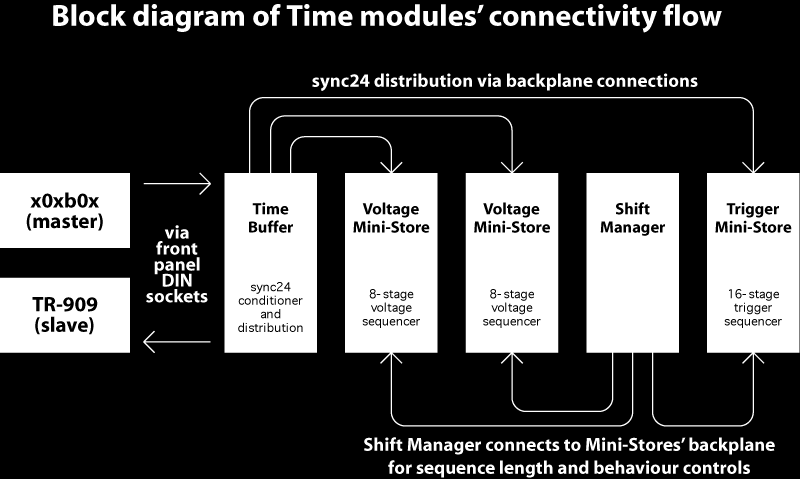
the Trigger Mini-Store
The Trigger Mini-Store is a 16 stage trigger sequencer which draws syncronisation from the Time Buffer, to allow it to run at musically-useful divisions of quarter notes, eighth notes, and sixteenth notes. There is a toggle to select its clock divisor, and this selection does not become active until the sequencer returns to stage one or advances to stage nine. Because of this behaviour logic, not only the toggle switches but the divisor control itself becomes an exciting performance control in a live or studio situation.
The control surface is, due to space considerations, split between column A and column B. The first 8 stages are in column A and the second 8 in column B. Both columns share 8 stage indicator LEDs, and have active column indicator LEDs underneath them. This arrangement may seem bizarre at first, but this is the way the Projekt Elektronik Voltage Store Units (Moog 960 expansion variety) which were commissioned by and designed for Tangerine Dream presented their controls as two courses of 8 controls with row indicator lamps, so I don't really see a problem with this.
There is also an external shift input which when a 1/4" TS cable is inserted breaks the connection with the internal sync24 bus and puts it under external control, to allow it to be driven from another Time module, or a simple oscillator. The response to external shift clock is well into the audio range, allowing this sequencer to become a sort of burst generator.
When connected to a Shift Manager panel, this sequencer becomes a seriously-enabled sequencing element. The Shift Manager allows you to control the sequence length from 2 to 16 stages, provides a Stage One trigger output and input, and allows you to set the sequencer to stop at the end of the sequence instead of cycle to stage one. The length control (like the clock divisor toggle) does not take effect until the sequencer cycles back to stage one or advances to stage nine. When a trigger is applied to the Stage One input the sequencer will hang at the first stage until the trigger signal is released to 0V, and then advances to the next stage at the next clock divisor or external shift input clock signal. The Stage One output pulses high whenever the sequencer is returned to stage one: under Sync24 control it is a short pulse and under external control the output is high for the duration of the pulse width of the external clock pulse. There is also a toggle switch which allows the sequence to end at whatever stage is selected with the sequence length rotary switch control, and the sequencer will only advance to the first stage when a pulse is applied to the Stage One input jack.
Here's a diagram to explain a bit more visually how it all fits together in an example use scenario:

This module only draws power from the 5 volt rail of your system.
The Trigger Mini-Store is now discontinued. A new trigger sequencer of some type will rise from its ashes in due time.